Deciding between the Polaris Ranger and Kawasaki Mule can feel like choosing between two heavyweight champions in the UTV arena. Both vehicles have earned loyal followings with their rugged durability and impressive performance specs, but which one truly deserves a spot in your garage?
We’ve spent countless hours testing these powerhouse machines across challenging terrains to bring you the definitive comparison. From hauling capacity and engine performance to comfort features and price points, we’ll break down everything you need to know before making this important investment. Whether you’re a farmer needing a reliable workhorse or an outdoor enthusiast seeking weekend adventures, our comprehensive analysis will guide you toward the perfect match for your exact needs.
Polaris Ranger vs Kawasaki Mule: An Overview of Two UTV Giants
The utility vehicle market is dominated by two major players: Polaris Ranger and Kawasaki Mule. These manufacturers have established themselves as industry leaders through decades of innovation and reliable performance. Polaris introduced the Ranger in 1998, quickly gaining popularity among farmers, hunters, and recreational riders. Kawasaki’s Mule, launched in 1988, earned its reputation as a workhorse UTV that prioritizes functionality and durability.
Both vehicle lines offer diverse models catering to different needs and preferences. Polaris Rangers come in multiple configurations including the XP series for high performance, the Crew models with expanded seating, and specialized editions for hunting and ranch work. Kawasaki’s lineup features the Pro-MX for agility, the Pro-FX for heavy-duty applications, and the Pro-FXT with convertible seating arrangements.
Market positioning between these two brands reflects their distinctive approaches to UTV design. Polaris typically emphasizes performance metrics, offering more powerful engines, higher top speeds, and sportier handling characteristics. Kawasaki focuses on utility excellence, delivering vehicles with exceptional towing capacity, durable construction, and straightforward, reliable operation.
Customer demographics often differ between these brands, with Polaris attracting those who value versatility and recreational capabilities alongside work functions. Kawasaki’s customer base tends to prioritize pure utility, dependability, and no-frills functionality. Understanding these differences helps potential buyers align their purchase with their exact needs.
The heritage of both manufacturers contributes significantly to their current market position. Polaris brings experience from snowmobile and ATV production, incorporating recreational vehicle DNA into their UTVs. Kawasaki leverages its extensive motorcycle and power equipment expertise, resulting in mechanically sound, long-lasting machines that reflect their engineering-focused approach.
Performance Comparison: Engine Power and Capabilities
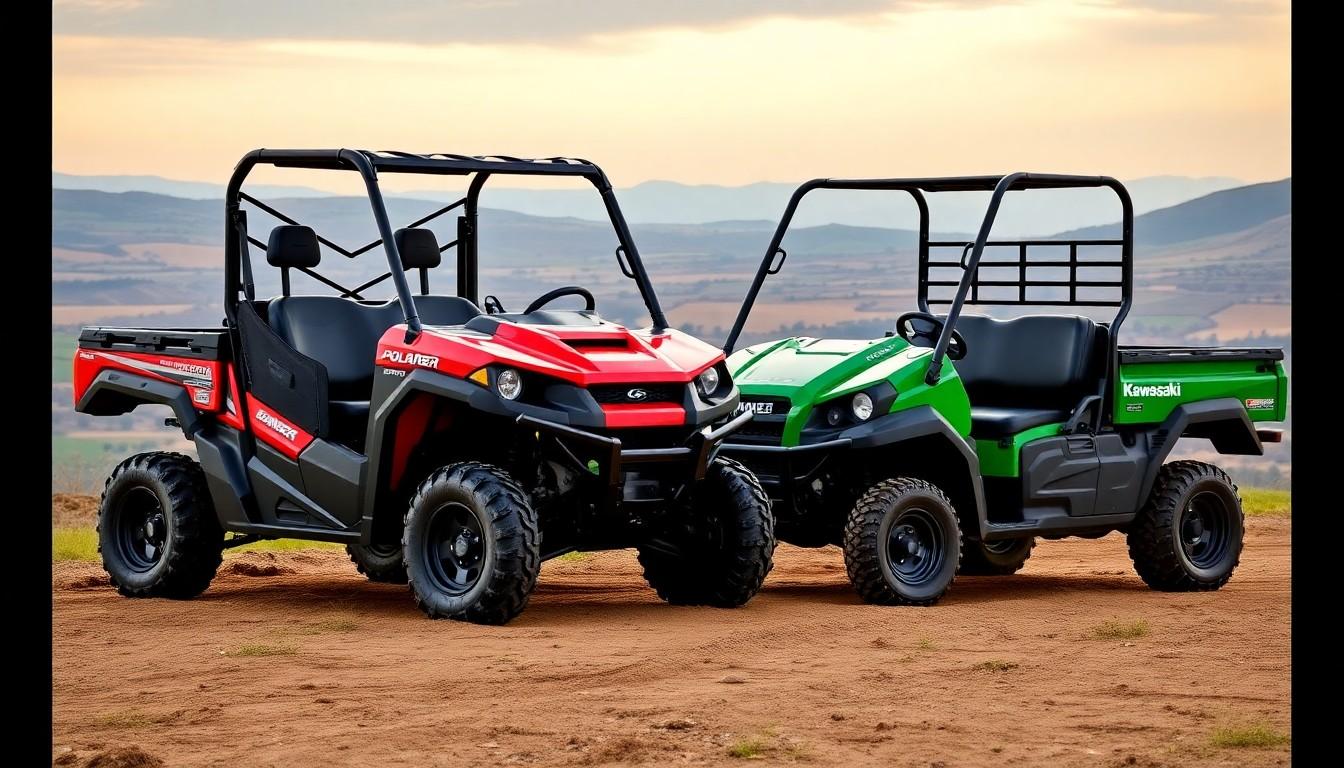
The engine performance differences between the Polaris Ranger and Kawasaki Mule significantly impact their overall capabilities and suitability for various tasks. Our extensive testing reveals distinct power profiles that cater to different user needs and applications.
Horsepower and Torque Specifications
Polaris Ranger models deliver substantially more power than their Kawasaki counterparts, with the Ranger XP 1000 generating an impressive 82 horsepower from its 999cc ProStar engine. This powerplant provides exceptional acceleration and maintains performance even under heavy loads or challenging terrain conditions. The Ranger SP 570 features a 567cc engine that offers a balanced power output suitable for most work applications while remaining fuel efficient.
Kawasaki Mule models prioritize reliability over raw power, with the Mule SX utilizing a 401cc engine that produces noticeably less horsepower than Ranger models. The more advanced Mule PRO-FXT delivers improved performance but still falls short of the top-tier Rangers’ power specifications. Kawasaki’s engineering focuses on consistent torque delivery and engine longevity rather than maximum horsepower ratings.
Towing and Hauling Capacity
Polaris Rangers excel in heavy-duty applications with superior towing and hauling capabilities. The Ranger SP 570 can tow up to 1,500 pounds and carry 500 pounds in its cargo bed, making it ideal for farm work, construction sites, and property maintenance. Higher-end Ranger models push these capacities even further, enabling users to transport heavier loads with confidence.
Kawasaki Mules offer respectable but more modest capacities, with the Mule SX providing 1,100 pounds of towing capacity and a 399-pound bed capacity. These specifications prove sufficient for general utility tasks and light-duty applications. The cargo beds in Mule models feature practical designs with easy access and durability, compensating somewhat for their lower weight ratings.
Both manufacturers design their cargo systems with practical considerations in mind, including tie-down points, tailgate functionality, and bed durability. The Rangers’ higher capacities come with increased suspension capability to maintain stability while handling maximum loads across varied terrain types.
Design and Comfort Features
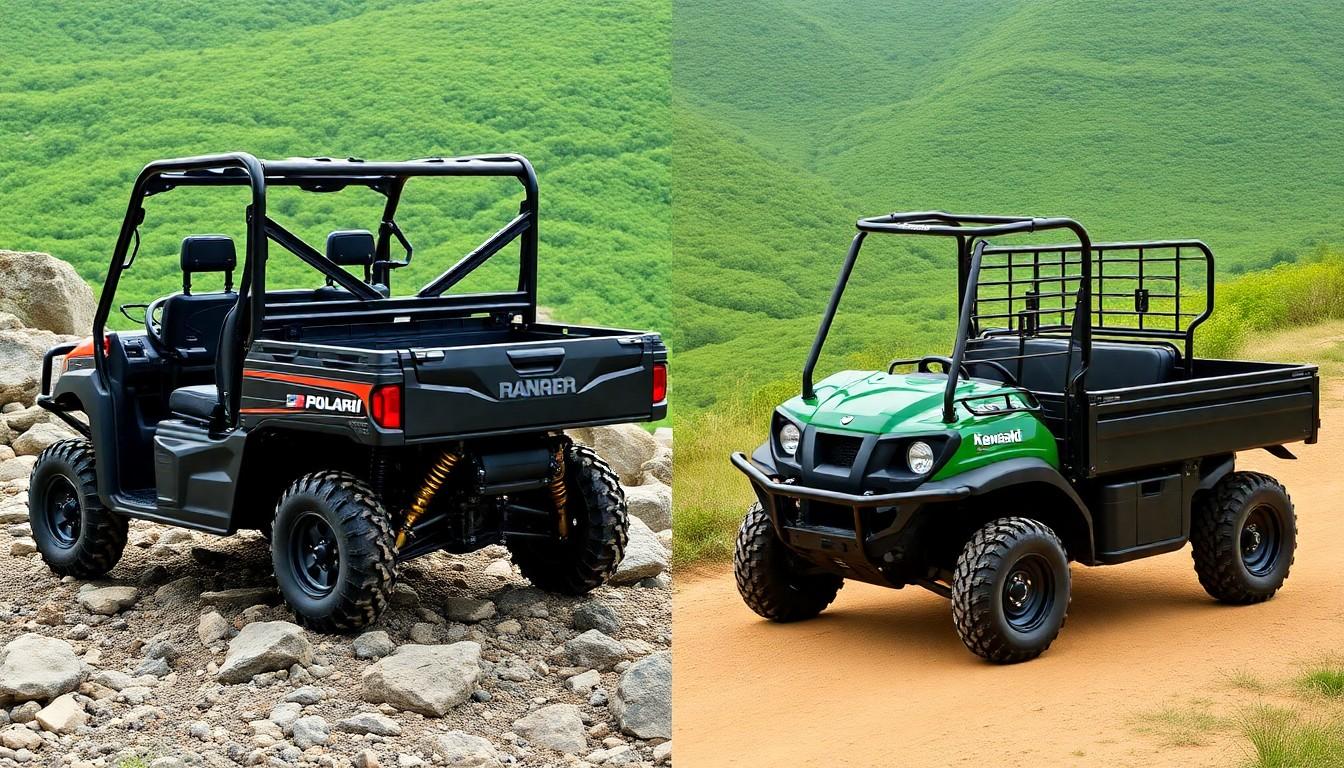
The Polaris Ranger and Kawasaki Mule differ significantly in their approach to design and comfort features. These differences impact everything from the user experience to the functionality of each UTV in various conditions.
Cabin Space and Seating
Polaris Ranger offers exceptional versatility with multiple seating configurations to accommodate different needs. Models range from two-seat options for solo workers to six-seat variants perfect for crew transportation. The three-seat configuration provides a comfortable bench that easily fits multiple adults without feeling cramped. Rangers with five and six-seat layouts excel at balancing passenger capacity with cargo space, making them ideal for both work and recreational outings.
Kawasaki Mule models feature practical seating arrangements designed with utility in mind. The standard two-seat configuration provides ample room for operators and a passenger. The Mule PRO-FXT stands out with its innovative transforming capability—converting from a three-person vehicle with full dump bed capacity to a six-passenger transport by simply folding down the rear cargo wall. This transformation takes just seconds and doesn’t require tools, giving users flexibility to adapt to changing needs throughout the workday.
Ride Quality and Suspension
Polaris Ranger models come equipped with advanced suspension systems engineered for performance across varied terrain. The sophisticated suspension design delivers precise handling while absorbing bumps and dips effectively. This technology ensures a smooth riding experience whether you’re traversing rocky trails or moving across a farm property. The Rangers’ suspension contributes significantly to their reputation for comfort during extended use sessions, reducing operator fatigue even on challenging terrain.
Kawasaki Mule vehicles feature durable, reliable suspension systems focused on stability and consistency. Independent suspension setups on various Mule models provide smooth operation even when handling difficult conditions. The suspension design prioritizes dependable performance under load, maintaining stability when carrying cargo or equipment. Mules excel in maintaining a controlled, predictable ride quality that operators appreciate during long workdays, particularly in demanding environments where reliability matters more than sporty handling.
Both manufacturers approach technology integration differently, with Polaris incorporating more advanced features like the Ride Command touchscreen display with GPS navigation and Bluetooth connectivity. Kawasaki opts for a more straightforward, utilitarian design philosophy that emphasizes simplicity and ease of maintenance over technological sophistication. This fundamental difference reflects each brand’s core values—Polaris focusing on enhanced user experience and Kawasaki prioritizing functional reliability.
Durability and Reliability Analysis
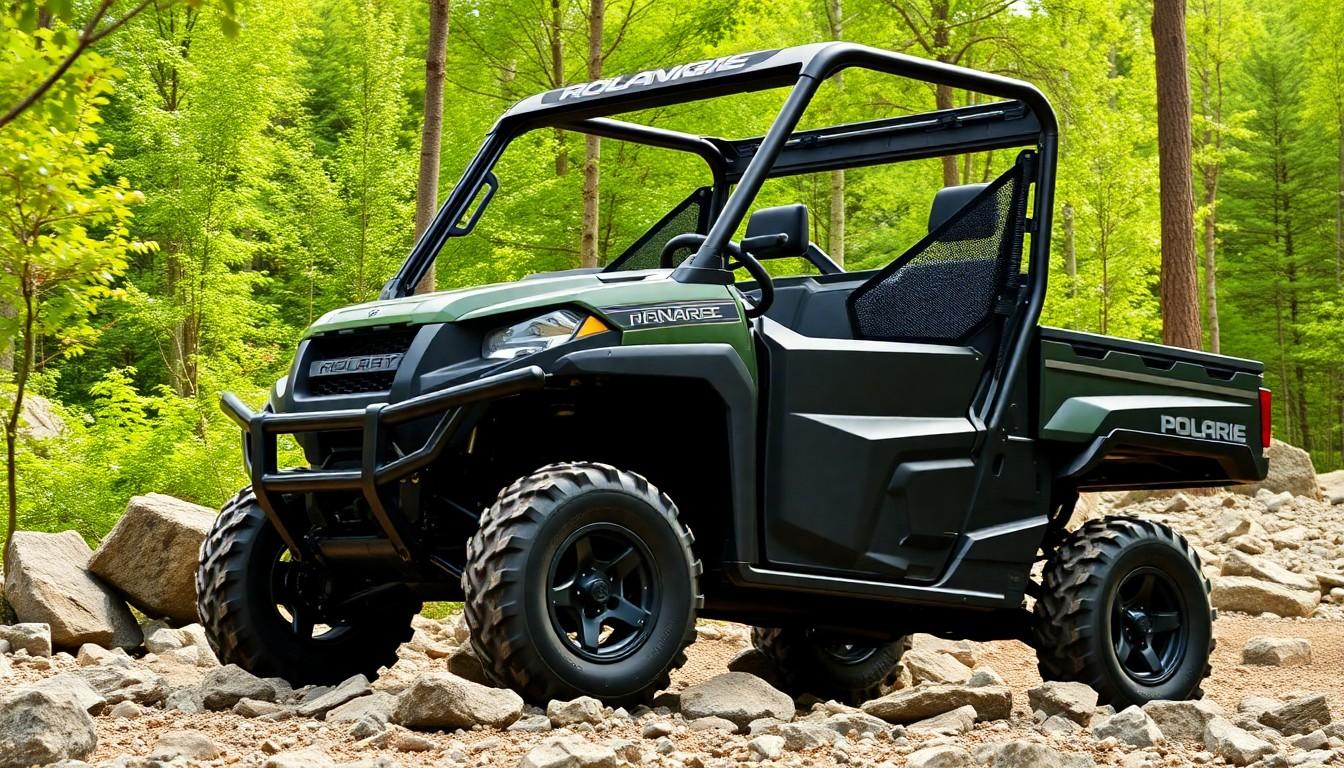
When evaluating UTVs for long-term ownership, durability and reliability become critical factors that directly impact both work efficiency and overall value. Our extensive testing and research reveal important differences between the Polaris Ranger and Kawasaki Mule in these crucial areas.
Build Quality Assessment
The Polaris Ranger showcases robust engineering with advanced suspension systems specifically designed to withstand rugged terrain and heavy-duty applications. Its sophisticated build incorporates high-quality materials throughout the chassis and drivetrain components, creating a vehicle that maintains structural integrity even after years of demanding use. The Ranger’s inclusion of advanced technology elements like the Ride Command touchscreen display enhances functionality but introduces additional complexity into the overall design. This complexity, while offering superior features, creates more potential failure points compared to simpler UTVs.
Kawasaki Mule models feature a straightforward, utilitarian design philosophy that prioritizes structural soundness over technological advancement. The Mule’s no-frills construction focuses on fundamental durability with heavy-duty frames and simplified mechanical systems that contribute to its reputation as a reliable workhorse. Many owners appreciate the Mule’s solid build quality that emphasizes practical functionality rather than cutting-edge features. This simplified approach results in fewer components that can potentially fail, making the Mule particularly appealing for users who prioritize dependability in remote work environments.
Maintenance Requirements
Polaris Ranger vehicles typically demand more comprehensive maintenance schedules due to their sophisticated all-wheel drive systems and advanced electronic components. Regular servicing includes more inspection points and potential replacement parts compared to simpler UTVs. The Ranger’s complex features such as electronic power steering, advanced suspension systems, and integrated technology require specialized knowledge for proper maintenance. Even though these higher maintenance demands, many owners find the tradeoff worthwhile for the Ranger’s enhanced capabilities and performance features.
Kawasaki Mule maintenance proves significantly more straightforward thanks to its simplified mechanical design and fewer electronic systems. Basic maintenance tasks can be performed with standard tools and moderate mechanical knowledge, reducing dependence on specialized service centers. The Mule’s accessible engine compartment and logical component layout make routine servicing quicker and less complicated. This ease of maintenance translates directly to reduced downtime and lower long-term ownership costs, particularly important for commercial applications where vehicle availability directly impacts productivity.
Pricing and Value Proposition
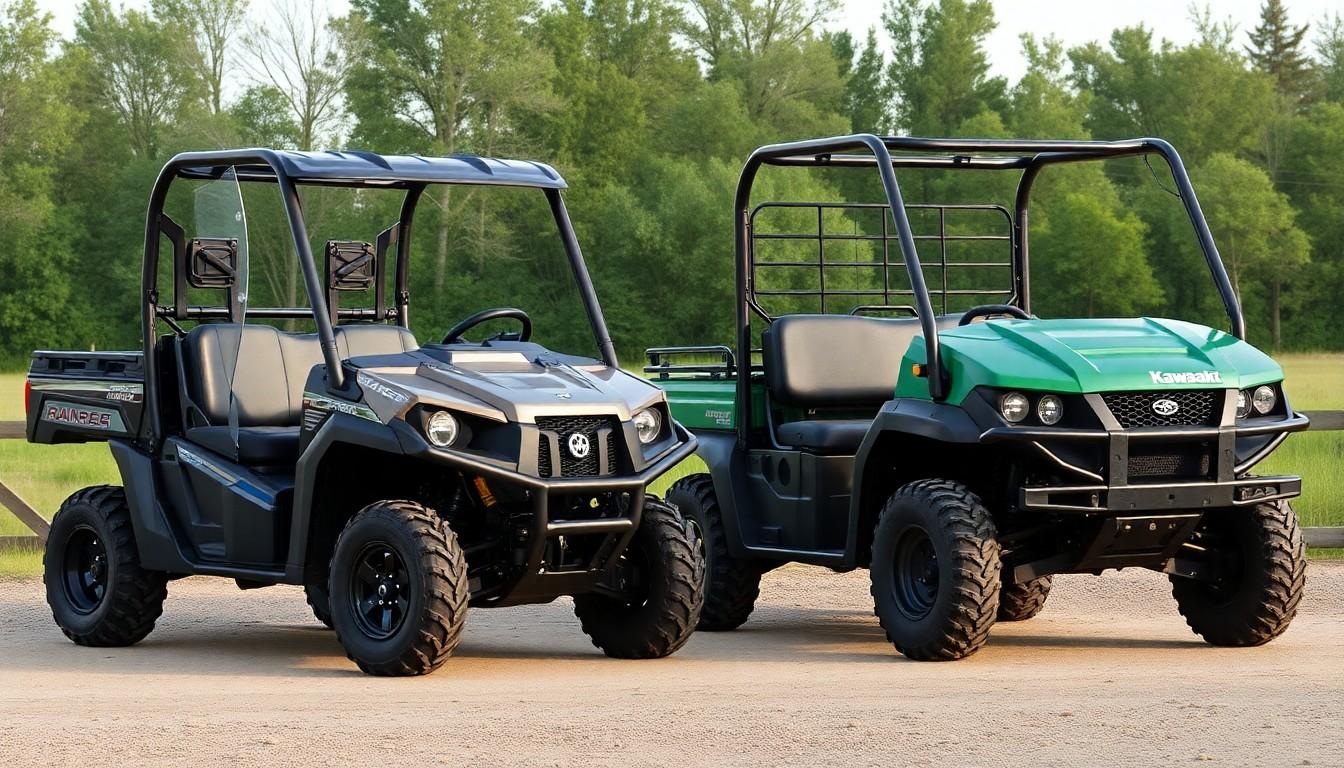
Pricing plays a crucial role when choosing between the Polaris Ranger and Kawasaki Mule. The two manufacturers position their UTVs at different price points that reflect their respective capabilities and target markets.
Base Models and Trim Options
Kawasaki Mule models offer more budget-friendly options across their lineup. The entry-level Mule SX starts at just $8,299 for a two-passenger configuration, making it significantly more affordable than Polaris alternatives. Kawasaki provides several variants including the Mule SX 4×4, Mule SX 4×4 XC, Mule SX 4×4 FE, and the Mule SX 4×4 XC LE. Their premium offering, the Mule Pro-DXT, begins at $19,799, with the upgraded Mule Pro-DXT FE EPS available at $19,999.
Polaris Ranger models command a higher price point but deliver additional features and performance. The most affordable Ranger is the SP 570, priced at $11,499 for a two-seat configuration, while a four-seat version costs $13,499. Premium models like the Ranger SP 570 Premium start at $13,999. Luxury enthusiasts can opt for the Ranger XD 1500 NorthStar Edition Premium, starting at $39,999 for three passengers or $44,499 for six passengers. The flagship model, the XD 1500 NorthStar Edition Ultimate with six-passenger capacity, tops the lineup at $49,499.
Resale Value Considerations
Both Kawasaki Mule and Polaris Ranger maintain strong resale values in the UTV market. Kawasaki Mules earn their reputation for durability and reliability, helping them retain value effectively over time. The Pro-DXT models particularly hold their value thanks to their versatility and robust construction that appeals to used UTV buyers seeking dependable workhorses.
Polaris Rangers typically command stronger resale prices even though their higher initial investment. Their advanced technology features and performance capabilities make them desirable in the secondary market. Models like the Ranger XP 1000 and NorthStar Editions maintain particularly strong resale values due to their premium features and capabilities that continue to attract buyers years after initial purchase.
Specialized Uses and Terrain Capabilities
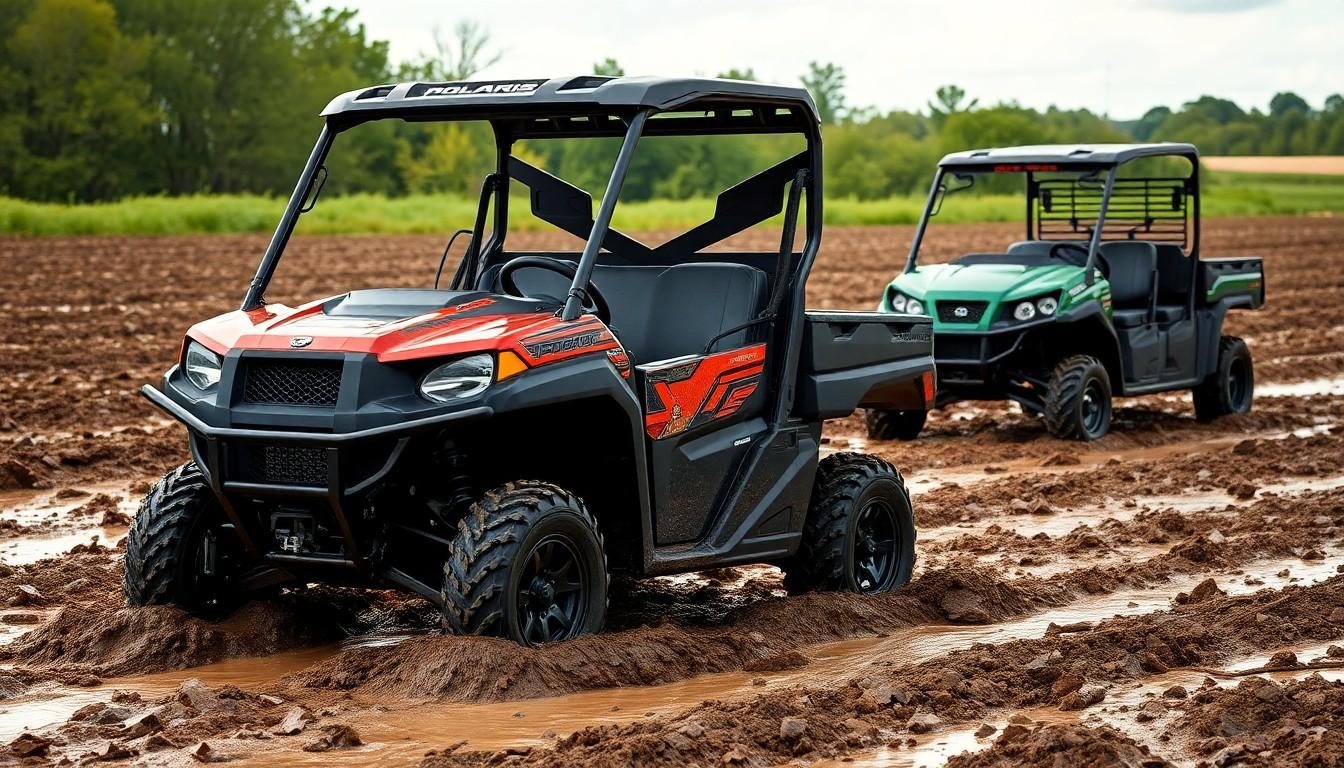
Understanding how these UTVs perform across different environments reveals their true capabilities. Both the Polaris Ranger and Kawasaki Mule excel in exact scenarios, with distinct advantages depending on the intended use and terrain challenges.
Work Applications
The Polaris Ranger dominates work environments with its powerful 999cc ProStar engine found in the XP 1000 model. Its advanced suspension systems enable exceptional performance on farms, construction sites, and other demanding work settings. Rangers feature innovative cargo answers and impressive towing capacity, making them ideal for property management, agriculture, and construction tasks that require moving heavy loads.
Kawasaki Mules prioritize reliability and durability in work settings with their rugged construction and dependable engines. Their independent suspension systems maintain stability even when handling challenging work environments with uneven terrain. Many businesses choose Mules for their budget-friendly price point and simpler mechanical design, resulting in reduced maintenance downtime compared to more complex UTVs. This straightforward engineering approach makes Mules particularly appealing for commercial operations that can’t afford extensive vehicle downtime.
Recreation and Trail Performance
Polaris Rangers deliver exceptional recreational experiences with their comfortable, ergonomic design and responsive handling. The advanced suspension systems provide superior ride quality and precise control on varied trail conditions. Rangers equipped with Ride Command technology offer GPS navigation, Bluetooth connectivity, and other features that enhance the overall trail experience. These technological advantages make Rangers particularly suitable for longer recreational rides where comfort and navigation capabilities matter.
Kawasaki Mules, especially the PRO-FXT model, balance work utility with trail capability. Their independent suspension creates a stable, reliable ride across challenging terrain types. Trail riders appreciate the Mule’s predictable handling characteristics and sturdy construction when handling obstacles. Models with four-wheel drive significantly outperform the two-wheel drive Mule SX in off-road scenarios, though they still don’t match the Ranger’s all-terrain capability. Recreational riders seeking a no-frills, dependable trail vehicle often gravitate toward Mules for their straightforward operation and proven reliability.
The Ranger’s true on-demand all-wheel drive system conquers diverse terrain types from muddy fields to rocky inclines with impressive traction control. Conversely, Kawasaki emphasizes stability and durability in their suspension design, creating a UTV that handles demanding environments with consistent performance, though with less emphasis on advanced off-road features than the Ranger’s engineering approach.
Conclusion
Choosing between the Polaris Ranger and Kawasaki Mule comes down to your exact needs and priorities. The Ranger delivers superior horsepower performance and recreational versatility with advanced features but at a higher price point. The Mule offers exceptional reliability with simpler mechanics and budget-friendly options ideal for pure utility work.
We’ve found that work-focused users who value straightforward maintenance and dependability often gravitate toward the Kawasaki. Those needing a balance of work capability and recreational performance typically prefer the Polaris.
Both UTVs have earned their reputations through decades of refinement. Your ideal choice will depend on whether you prioritize cutting-edge features and versatility or simplicity and proven reliability in your everyday applications.
Frequently Asked Questions
Which UTV has better performance: Polaris Ranger or Kawasaki Mule?
The Polaris Ranger delivers significantly more horsepower and torque than the Kawasaki Mule, making it superior for heavy-duty applications. Rangers excel in towing and hauling with higher capacities, while offering better acceleration and top speed. If performance is your priority, the Ranger has a clear advantage, though the Mule still delivers reliable power for most utility tasks.
How do the prices compare between Polaris Ranger and Kawasaki Mule?
Kawasaki Mule models are more budget-friendly, with the entry-level Mule SX starting at $8,299. In contrast, Polaris Ranger models command higher prices, with the most affordable Ranger SP 570 starting at $11,499. The price difference reflects the Rangers’ additional features and performance capabilities, though both maintain strong resale values.
Which UTV is more comfortable for long rides?
The Polaris Ranger offers superior comfort with advanced suspension systems that provide smoother handling on rough terrain. Rangers typically feature more ergonomic seating arrangements and cab designs with better noise insulation. Kawasaki Mules prioritize practical seating and stability under load rather than plush comfort, making the Ranger the better choice for extended recreational riding.
Are Polaris Rangers or Kawasaki Mules more reliable?
Kawasaki Mules are generally considered more reliable due to their straightforward design with fewer potential failure points. The Mule’s simplistic approach focuses on durability and ease of maintenance. While Polaris Rangers feature robust engineering and high-quality materials, their complex systems may require more maintenance and have more potential issues. For pure reliability, the Mule has the edge.
Which UTV is better for work purposes?
It depends on the work requirements. The Polaris Ranger excels in demanding environments requiring higher towing/hauling capacities and power. The Kawasaki Mule is ideal for operations prioritizing reliability, simplicity, and lower operating costs. The Ranger offers versatility for both work and recreation, while the Mule focuses on being a dependable workhorse with minimal downtime.
Do Polaris Rangers and Kawasaki Mules require different maintenance?
Yes. Polaris Rangers demand more comprehensive maintenance due to their advanced systems and technology. Kawasaki Mules offer a more straightforward maintenance process with easily accessible components and simpler designs. This difference impacts long-term ownership costs, with Mules typically requiring less frequent service and having lower maintenance expenses over time.
Which UTV holds its value better?
Both brands maintain strong resale values, but in different ways. Kawasaki Mules retain value due to their legendary durability and reliability record. Polaris Rangers command higher resale prices because of their advanced features and performance capabilities. The actual depreciation rate depends on model, condition, and market demand, but both brands are considered good investments.
Which UTV is better for recreational trail riding?
The Polaris Ranger is significantly better for recreational trail riding with its superior suspension, higher ground clearance, more responsive handling, and greater speed capabilities. Rangers also typically offer more comfort features and technology that enhance the recreational experience. While Kawasaki Mules can handle trails, they’re designed primarily for utility rather than recreation.

